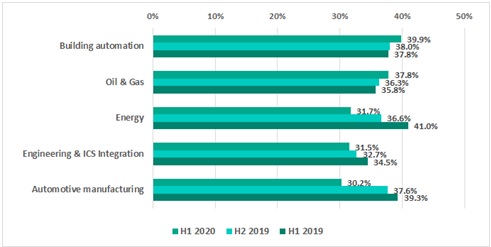Over the first six months of 2020, the percent of systems attacked
in the oil & gas and building automation industries increased when
compared to H1 and H2 2019. This growth occurred as thepercent of industrial
control system (ICS) computers attacked in most industriesdeclined as cybercriminals
shifted their focus to distributing more targeted and focused threats.
Attacks against industrial organizations always carry the potential to be
particularly devastating, both in terms of disruption to production and financial losses.
In addition,attacks against industrial enterpriseshave become more targeted,
organized by sophisticated threat actors with extensive resources whose goals
may not just be financial gain but also cyberespionage.
This past winter, spring and early summer, the industries most proneto attacks
were building automation and oil & gas. Attacks against the latter have the potential
to be particularly devastating given the massive financial losses already
incurred as a result of the recent pandemic. The percentage of ICS computers
on which malicious objects were blocked grew from 38% in H2 2019 to
39.9% in H1 2020 in the building automation industry and 36.3 to 37.8% in theoil & gas industry.
Percentage of ICS computers on which malicious objects were blocked in selected industries
Building automation systems, in general, tend to be more often exposed to attacks.
They often have a larger attack surface than traditional ICS computers because
they are frequently connected to corporate networks and the Internet. At the same time,
because they traditionally belong to contractor organizations, these systems
are not always managed by the organization’s corporate information security
team—making them an easier target
The growth in the percent of ICS computers attacked in the oil & gas
industry can be traced back to the development of a variety of worms
(malicious programs that self-replicate on the infected device)written in script languages,
specifically Python and PowerShell. These worms are able to gather
authentication credentials from the memory of system processes using
different versions of theMimikatz utility. From the end of March to
mid-June 2020, a large number of these worms were detected,
primarily in China and the Middle Eas
The increase in the percent of ICS systems attacked in the oil & gas
and building automation industries was the exception for the first half of 2020:
the percent of systems attacked in most other industries declined.
This occurred as attackers appeared to shift their focus from mass attacks to
distributing more focused and targeted threats, including backdoors
(dangerous Trojans that gain remote control over the infected device),
spyware (malicious programs designed to steal data) and ransomware
attacks (which tend to target specific enterprises).
In fact, there were noticeably more families of backdoors and spyware built
on the .NET platform that were detected and blocked on ICS computers.
The percent of ICS computers affected by ransomware grew slightly in H1 2020 when
compared to H2 2019 across all industries,
with a series of attacks witnessed against medical facilities and industrial companies.
Industrial companies were also the victim of sophisticated campaigns
by advanced persistent threat (APT) actors
“Thepercent of ICS computers attacked across most industries is declining.
However, there are still threats to contend with.
The more targeted and sophisticated attacks are,
the greater potential they have to cause significant damage—even if they
occur less frequently
What’s more, with many enterprises forced to work remotely and sign in to
corporate systems from home, ICS have naturally become more exposed to cyberthreats.
And with fewer on-sight personnel, there are fewer people available to
respond and mitigate an attack, meaning the consequences may be far more devastating.
Given that the oil & gas and building automation infrastructures appear
to be apopular target among attackers, it’s crucial that these system owners and
operators take extra security precautions,”comments EvgenyGoncharov,
security expert at Kaspersky
Learn more about the industrial threat landscape for H1 2020 onICS CERT.
To keep your ICS computers protectedfrom various threats, Kaspersky experts recommend:
· Regularly update operating systems and application software that are part of the
enterprise’s industrial network. Apply security fixes and patches to ICS
network equipment as soon as they are available.
· Conductregular security audits of OT systems to identify and eliminate possible vulnerabilities.
· Use ICS network traffic monitoring, analysis and detection
solutions for better protection from attacks potentially threatening
technological process and main enterprise assets.
· Dedicated ICS security training for IT security teams and OT engineers
is crucial to improve response to new and advanced malicious techniques.
· Provide the security team responsible for protecting industrial
control systems with up-to-date threat intelligence.
ICS Threat Intelligence Reporting service provides insights into current
threats and attack vectors, as well as the most vulnerable elements in OT and
industrial control systems and how to mitigate them.
· Use security solutions for OT endpoints and network such as Kaspersky
Industrial CyberSecurity to ensure comprehensive protection for all industry critical systems.
It is no less important to protect IT infrastructure as well.
Integrated Endpoint Security protects corporate endpoints and
enables automated threat detection and response capabilities
 التكنولوجيا وأخبارها بوابة مصر لأخبار تكنولوجيا المعلومات والإتصالات
التكنولوجيا وأخبارها بوابة مصر لأخبار تكنولوجيا المعلومات والإتصالات







